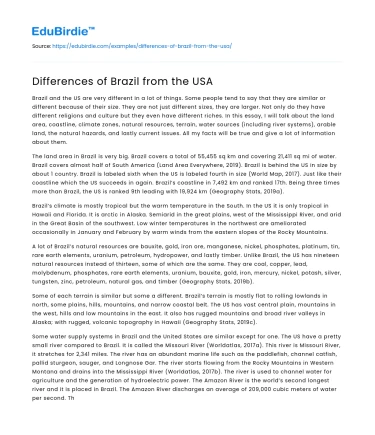Brazil and the US are very different in a lot of things. Some people tend to say that they are similar or different because of their size. They are not just different sizes, they are larger. Not only do they have different religions and culture but they even have different riches. In this essay, I will talk about the land area, coastline, climate zones, natural resources, terrain, water sources (including river systems), arable land, the natural hazards, and lastly current issues. All my facts will be true and give a lot of information about them.
The land area in Brazil is very big. Brazil covers a total of 55,455 sq km and covering 21,411 sq mi of water. Brazil covers almost half of South America (Land Area Everywhere, 2019). Brazil is behind the US in size by about 1 country. Brazil is labeled sixth when the US is labeled fourth in size (World Map, 2017). Just like their coastline which the US succeeds in again. Brazil’s coastline in 7,492 km and ranked 17th. Being three times more than Brazil, the US is ranked 9th leading with 19,924 km (Geography Stats, 2019a).
Save your time!
We can take care of your essay
- Proper editing and formatting
- Free revision, title page, and bibliography
- Flexible prices and money-back guarantee
Brazil’s climate is mostly tropical but the warm temperature in the South. In the US it is only tropical in Hawaii and Florida. It is arctic in Alaska. Semiarid in the great plains, west of the Mississippi River, and arid in the Great Basin of the southwest. Low winter temperatures in the northwest are ameliorated occasionally in January and February by warm winds from the eastern slopes of the Rocky Mountains.
A lot of Brazil’s natural resources are bauxite, gold, iron ore, manganese, nickel, phosphates, platinum, tin, rare earth elements, uranium, petroleum, hydropower, and lastly timber. Unlike Brazil, the US has nineteen natural resources instead of thirteen, some of which are the same. They are coal, copper, lead, molybdenum, phosphates, rare earth elements, uranium, bauxite, gold, iron, mercury, nickel, potash, silver, tungsten, zinc, petroleum, natural gas, and timber (Geography Stats, 2019b).
Some of each terrain is similar but some a different. Brazil’s terrain is mostly flat to rolling lowlands in north, some plains, hills, mountains, and narrow coastal belt. The US has vast central plain, mountains in the west, hills and low mountains in the east. It also has rugged mountains and broad river valleys in Alaska; with rugged, volcanic topography in Hawaii (Geography Stats, 2019c).
Some water supply systems in Brazil and the United States are similar except for one. The US have a pretty small river compared to Brazil. It is called the Missouri River (Worldatlas, 2017a). This river is Missouri River, it stretches for 2,341 miles. The river has an abundant marine life such as the paddlefish, channel catfish, pallid sturgeon, sauger, and Longnose Gar. The river starts flowing from the Rocky Mountains in Western Montana and drains into the Mississippi River (Worldatlas, 2017b). The river is used to channel water for agriculture and the generation of hydroelectric power. The Amazon River is the world’s second longest river and it is placed in Brazil. The Amazon River discharges an average of 209,000 cubic meters of water per second. That is massive compared to the Missouri River. Anaconda, river dolphin, and over 5,600 species of fish are some of the animals found in the Amazon basin (Worldatlas, 2017c).
Arable land is a big thing for both countries. Brazil is the largest exporter of coffee, soybeans, beef, sugar cane, ethanol and frozen chickens in the world. The best investment in Brazil is to find a cattle farm that is in operation and to transform this into a soy, rice or corn farm. Doing so requires more work and attention, however Big Lands Brazil is on the ground to assist in this type of project (Big Lands Brazil, n.d.).
Brazil has horrible natural hazards. 6.4 million people moved after large-scale flooding, droughts, and other natural hazards (Phillips, 2019). 1.6 Brazilians were forced out by large-scale construction projects such as dams (Phillips, 2019). Like Brazil, the US has many horrible and traumatizing natural hazards. Every year in the United States, natural hazards threaten lives and livelihoods and result in billions of dollars in damage (Mission Areas, 2019).
There are always problems in countries and I have something to show for it. Brazil has access to free public education and most of the children don't even try or give an effort to go or learn. Poorer kids could even try to go to school but can't because they would probably have to help out in the house or make money that day (Brazil, 2010). Brazil isn’t perfect and does have a crime rate. The most common forms of crime in this country include mugging, robbing, kidnapping and gang violence.
In conclusion, as can be seen from the information presented in this essay, Brazil clearly has significant differences from the United States, despite the common perception of their similarities.
References
- Big Lands Brazil (n.d.). Farming. Retrieved from https://www.biglandsbrazil.com/farming/
- Brazil (2010). Brazilian Social Issues. Retrieved from https://www.brazil.org.za/social-issues.html
- Geography Stats (2019, January 9). Brazil vs the United States. Retrieved from https://www.nationmaster.com/country-info/compare/Brazil/United-States/Geography/table
- Land Area Everywhere (2019). Land Area in Brazil. Retrieved from https://www.google.com/search?q=Land+aread+in+Brazil&rlz=1CAIXET_enUS815&oq=Land+aread+in+Brazil&aqs=chrome..69i57.6689j0j7&sourceid=chrome&ie=UTF-8&safe=active&ssui=on
- Mission Areas (2019, April 24). Natural Hazards. Retrieved from https://www.usgs.gov/mission-areas/natural-hazards
- Phillips, D. (2019, March 5). Brazil: Natural Disasters and Large-Scale Construction Forced Millions from Homes. Retrieved from https://www.theguardian.com/world/2018/mar/07/at-least-77m-brazilians-forced-to-leave-homes-since-2000-natural-disasters-dam-building-brazil
- World Atlas (2017, April 25). Biggest Rivers In Brazil. Retrieved from https://www.worldatlas.com/articles/the-biggest-rivers-in-brazil.html
- World Atlas (2017, April 25). Longest Rivers In The United States. Retrieved from https://www.worldatlas.com/articles/longest-rivers-in-the-united-states.html
- World Map (2017, January 17). Land Area/ Countries of the World. Retrieved from http://world.bymap.org/LandArea.html






 Stuck on your essay?
Stuck on your essay?

